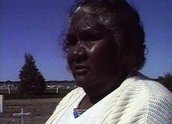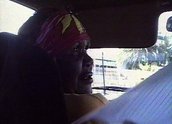


My Life as I Live It (1993)
Synopsis
My Life as I Live It follows on from My Survival as an Aboriginal (1978), which introduced Essie Coffey (‘Bush Queen’) and her community in north-west New South Wales (Dodge City). My Life as I Live It returns to Dodge City where Essie and the ‘A-Team’ have nominated for the local council elections. The interweaving of black-and-white footage from My Survival with new colour observational footage and interviews illustrates that while some things have changed, others have stayed the same. The Community Development Employment Projects have created hope for self-determination but racism still raises its ugly head. Essie continues to be 'a fighter and a voice of her people’. She is as passionate, feisty, charismatic, humorous and determined as she was in the earlier film.
Curator’s notes
My Life as I Live It was directed by Essie Coffey with cinematographer and filmmaker Martha Ansara and editor Kit Guyatt. Throughout, Essie tells the audience her innermost thoughts and ideas. She is realistic about life in her remote community but also explains the possible ways out of the deprivation and depression she encounters there. Essie feels strongly about the land and is a great believer in self-determination. While she is happy, her life has been a struggle and she doesn’t shy away from showing it as it is. She dedicates My Life as I Live It to the large number of people who have passed away, many from the effects of alcohol, since the first film.
My Life as I Live It proved to be even more of a collaborative effort with Martha Ansara and Kit Guyatt than My Survival as an Aboriginal (1978) because Essie was not well throughout filming. Finally, Martha had to drag Essie from her hospital bed to complete the narration. Essie then rallied, claiming it was the emu meat that had improved her health, and was able to launch the film at the Chauvel Cinema in Sydney in 1993. Shortly after, she suffered kidney failure. Remaining in Brewarrina, Essie’s health problems could not curtail her political activity. She passed away on 3 January 1998, aged 56.
A Muruwari woman, Essie was born near Goodooga in New South Wales. With her husband, Albert 'Doc’ Coffey, she settled on the banks of the Barwon River in Brewarrina in the mid-1950s and raised eight children of her own and adopted ten others. Essie co-founded the Western Aboriginal Legal Service, and was an inaugural member of the Council for Aboriginal Reconciliation. She supervised the CDEP in Brewarrina, was a member of the Wakamurra ATSIC Regional Council and co-founder of the Aboriginal Heritage and Culture Museum of Brewarrina. In 1985, Essie was awarded the Order of Australia for her services to her people but refused an MBE saying she was 'an Australian and not a member of the British Empire’.
My Life as I Live It was selected for the prestigious Margaret Mead Film Festival in New York. It screened on both SBS (14 December 1994) and ABC (11 July 1995) television and was broadcast on NITV, National Indigenous Television, in December 2007.
Secondary curator’s notes
by Liz McNivenAfter making My Survival as an Aboriginal (1978) 15 years earlier, Martha Ansara and Essie Coffey revisit the Aboriginal people of Brewarrina in north-west New South Wales to make My Life as I Live It. The collaboration gave Coffey, an Aboriginal activist, access to the film industry and Ansara, a documentary filmmaker, access to the Brewarrina Aboriginal community.
This filmmaking duo produced two outstanding films, providing their audiences, many for the first time, with an insight into an Aboriginal worldview. Both films look at the peoples’ connections to their family and cultural heritage and their ongoing struggle for equity in Brewarrina.
My Survival as an Aboriginal (1978) documented the depression and frustration felt by Aboriginal people in the late 1970s. It covered issues including the very high rate of unemployment, the lack of representation, overcrowded housing, and the overwhelming poverty experienced by the residents of the ‘Dodge City’ Aboriginal mission. The film shows how the peoples’ maintenance of their cultural heritage kept them alive as they tracked small game, hunted larger animals and gathered bush foods and medicines.
By contrast with the first film, My Life as I Live It (1993) presents an optimistic outlook for the Aboriginal people of Brewarrina, with the introduction of the federal government’s Community Development Employment Projects (CDEP). For the first time, through this scheme, Aboriginal people were able to gain a stake in their local economy, with the CDEP able to tender for local contracts, provide workers for local businesses and establish community-based enterprises.
The death in custody of Lloyd Boney marked the lowest point in the Brewarrina Aboriginal community’s relationship with the police. My Life as I Live It goes into this story from the Aboriginal community’s perspective. It then shows Aboriginal community members working in partnership with the local police. This demonstrates the peoples’ resilience, their ability to overcome trauma and to forge ahead to build a better community.
The employment of Aboriginal workers in the local school to support the children’s formal and cultural education highlights a new approach to learning. The film shows a teacher’s aide supporting the students in the classroom and an artist working with the children on a mural. Most importantly, the film documents Aboriginal representatives organising to run in the local council elections, with one member winning a seat. All these factors point to a better future for the Aboriginal people of Brewarrina.
The film flashes back to the people in My Survival as an Aboriginal showing them 15 years later. It is amazing to watch their transformation from toddlers to teenagers, from teenagers to adults. Some of these people’s stories, laced with sadness, highlight the importance of the struggle by the Bush Queen, Essie Coffey, and others member of her community to improve the socio-economic outlook for their people.
Now nearly 20 years after the making of My Life as I Live It and 35 years after the production of My Survival as an Aboriginal, it would be interesting to revisit this small Aboriginal community again. To follow up on the people’s struggle to maintain their cultural heritage and identity and their endeavour to gain an equitable stake in the future.
- Overview
- Curator’s notes
- Video 3 clips
- Principal credits
- Find a copy
- Make a comment
- Map
- Add your review




